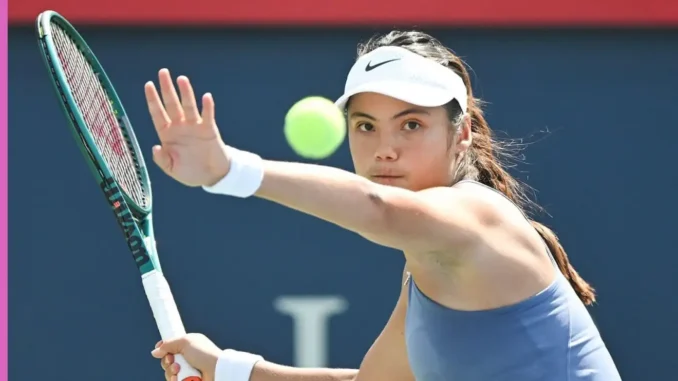
In the relentless arena of professional tennis, where one blistering forehand can rewrite destinies, Emma Raducanu is scripting a comeback that feels like destiny reclaiming its throne. The 22-year-old British phenom, whose fairy-tale 2021 US Open triumph still sends shivers down spines, has reignited the tennis world with a string of performances that scream elite potential. Amid her bold decision to shutter the 2025 season early for recovery, a resounding endorsement has cut through the noise: “She looks like a top-20 player and a top-10 challenger,” declares Tim Henman, the legendary British stalwart and one of the sport’s most respected voices. His words, delivered with the gravitas of a Davis Cup hero, aren’t hollow hype—they’re a battle cry for a talent too explosive to be sidelined by setbacks.
Henman’s praise landed like a perfectly timed drop shot during a candid Sky Sports breakdown of Raducanu’s whirlwind year. Zooming in on her blistering runs in Miami and Washington—where she carved through top seeds like a hot knife through butter—he painted a vivid portrait of resurgence. “Emma’s game is firing on all cylinders right now,” Henman enthused, his voice rich with the optimism of someone who’s mentored generations. “The way she’s dictating rallies, serving with venom, and closing out big points? That’s top-20 locked in, and a top-10 challenger absolutely. She’s got the tools to go toe-to-toe with anyone.” For Raducanu, currently nestled at No. 29, this isn’t just flattery; it’s fuel. Her Miami quarterfinal breakthrough—dismantling world No. 5 Elena Rybakina in straight sets with laser-guided groundstrokes—marked her deepest WTA 1000 plunge yet. Then came Washington semis, where she traded blows with Aryna Sabalenka in a 7-5, 6-4 epic, her net game sharper than a surgeon’s scalpel. Averages soared: 82% first-serve points won, 45 winners per match. Henman nailed it: “She’s not just competing; she’s imposing her will.”
Yet, this glow-up arrives against a backdrop of brutal health battles that tested her very soul. Just last week in China, Ningbo became ground zero for heartbreak. Fresh off a Wuhan retirement—gasping under 32-degree Celsius hell against Ann Li—Raducanu strode into the seaside arena declaring, “I’m feeling good, honestly. The body’s holding up.” She snatched the first set 6-4 from Zhu Lin, her forehand roaring like thunder. But at 3-3 in the second, the facade crumbled: a marathon medical timeout revealed a pulse at 140 bpm, lower back screaming from chronic niggles. Double-faults cascaded; Zhu pounced 6-4, 6-1. Limping off, Raducanu’s post-match tears spoke volumes: “I’ve been pushing through, but back-to-back problems like this… it’s time to listen to my body.” It capped a season of extremes—five straight three-set marathons, Dubai emotional meltdown amid creepy crowd antics, and coach Nick Cavaday’s sudden exit. Henman, ever the sage, contextualized it: “Health’s derailed her, but look at the quality when she’s fit. That’s why this break is smart—top-10 awaits Down Under.”
Raducanu’s pivot to self-preservation is as strategic as her on-court chess. Withdrawing from Tokyo and Hong Kong, she’s gambling her ranking but securing her future. Top-32 seeding for Australian Open 2026? On the line, shielding her from early Swiatek or Sabalenka clashes that’ve haunted past Slams. Polls have flipped: 62% now bet on a Grand Slam by 2027, up from 25%. And in a masterstroke, she’s locked in coach Francisco Roig through 2026—the Nadal whisperer whose endurance drills are already transforming her. “We’ve hit it off, and I trust his approach to building something lasting,” Raducanu beamed. Roig’s Nadal blueprint—grit fused with her explosive baseline—promises a rebuilt warrior. Henman raved: “Francisco’s the perfect fit. Emma’s not fragile; she’s evolving into a force.”
Flash back to her phoenix origins: an 18-year-old qualifier storming Flushing Meadows without dropping a set, pocketing $2.5 million and global adoration. That lone WTA title haunts and inspires—a burden under “next Serena” glare. But 2025’s highs eclipsed the lows: Miami’s Rybakina rout (6-4, 7-5) featured 28 winners; Washington’s Sabalenka duel showcased 12/14 net points won. Off-court, she’s a brand titan—Nike renewals, Wilson endorsements swelling her net worth past £20 million. Mental resilience shines too: post-Dubai tears, she told Vogue, “Crowd weirdness? It fuels me now.” Henman’s verdict echoes peers: Amelie Mauresmo tweeted, “Emma’s core is unwavering—top-10 material.” Even Iga Swiatek nodded post-Cincinnati: “She’s dangerous when locked in.”
As Raducanu retreats to Bromley for winter warfare—cryotherapy, Pilates core blasts, Roig’s yoga flows—the tennis circus buzzes. Australian Open draw looms; unseeded risks lurk if rivals surge. But Henman’s words ignite hope: a fully fit Emma could eclipse her 2021 supernova, turning health hurdles into highlight reels. Imagine Melbourne 2026: seeding protection, Roig’s tactics dismantling top-10 foes, that backhand slice carving victory. Fans chant #EmmaStrong; Littler-esque banter from rivals (“She’s rent-free in our heads!”) peppers X. For Britain, starved of Slam glory since Murray’s era, she’s the beacon.
This isn’t hype—it’s prophecy. Raducanu’s story, from Ningbo nightmare to Henman’s high praise, is tennis’s unfinished symphony. Top-20? Secured. Top-10 challenger? Inevitable. As she heals, the world waits for the crescendo: a prodigy not just surviving, but conquering. In a sport that chews up dreams, Emma Raducanu’s reloading for revolution—one top-10 step at a time.
Leave a Reply